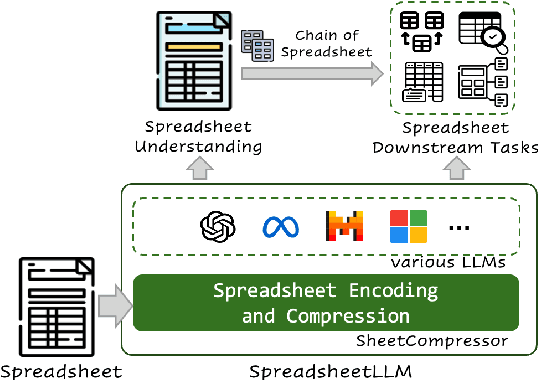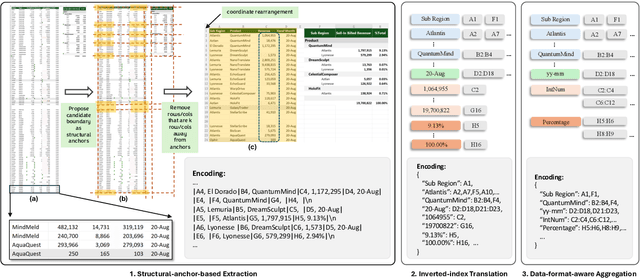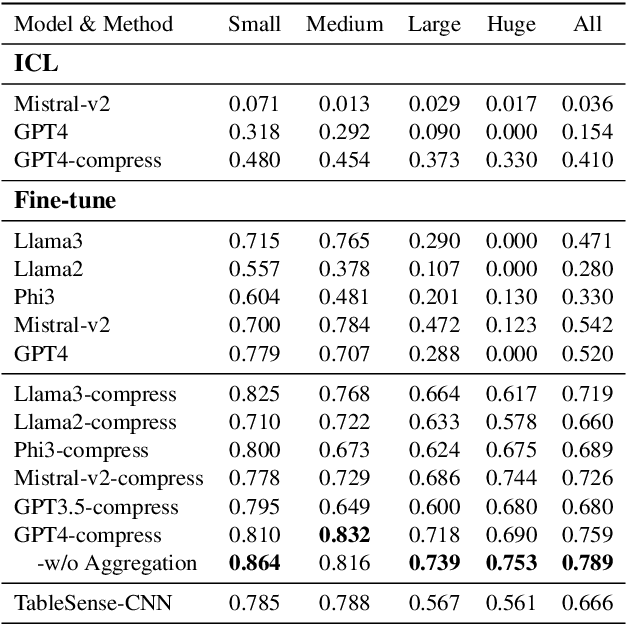Shi Han
TwT: Thinking without Tokens by Habitual Reasoning Distillation with Multi-Teachers' Guidance
Mar 31, 2025Abstract:Large Language Models (LLMs) have made significant strides in problem-solving by incorporating reasoning processes. However, this enhanced reasoning capability results in an increased number of output tokens during inference, leading to higher computational costs. To address this challenge, we propose TwT (Thinking without Tokens), a method that reduces inference-time costs through habitual reasoning distillation with multi-teachers' guidance, while maintaining high performance. Our approach introduces a Habitual Reasoning Distillation method, which internalizes explicit reasoning into the model's habitual behavior through a Teacher-Guided compression strategy inspired by human cognition. Additionally, we propose Dual-Criteria Rejection Sampling (DCRS), a technique that generates a high-quality and diverse distillation dataset using multiple teacher models, making our method suitable for unsupervised scenarios. Experimental results demonstrate that TwT effectively reduces inference costs while preserving superior performance, achieving up to a 13.6% improvement in accuracy with fewer output tokens compared to other distillation methods, offering a highly practical solution for efficient LLM deployment.
TablePilot; Recommending Human-Preferred Tabular Data Analysis with Large Language Models
Mar 17, 2025Abstract:Tabular data analysis is crucial in many scenarios, yet efficiently identifying the most relevant data analysis queries and results for a new table remains a significant challenge. The complexity of tabular data, diverse analytical operations, and the demand for high-quality analysis make the process tedious. To address these challenges, we aim to recommend query-code-result triplets tailored for new tables in tabular data analysis workflows. In this paper, we present TablePilot, a pioneering tabular data analysis framework leveraging large language models to autonomously generate comprehensive and superior analytical results without relying on user profiles or prior interactions. The framework incorporates key designs in analysis preparation and analysis optimization to enhance accuracy. Additionally, we propose Rec-Align, a novel method to further improve recommendation quality and better align with human preferences. Experiments on DART, a dataset specifically designed for comprehensive tabular data analysis recommendation, demonstrate the effectiveness of our framework. Based on GPT-4o, the tuned TablePilot achieves 77.0% top-5 recommendation recall. Human evaluations further highlight its effectiveness in optimizing tabular data analysis workflows.
TableLoRA: Low-rank Adaptation on Table Structure Understanding for Large Language Models
Mar 06, 2025Abstract:Tabular data are crucial in many fields and their understanding by large language models (LLMs) under high parameter efficiency paradigm is important. However, directly applying parameter-efficient fine-tuning (PEFT) techniques to tabular tasks presents significant challenges, particularly in terms of better table serialization and the representation of two-dimensional structured information within a one-dimensional sequence. To address this, we propose TableLoRA, a module designed to improve LLMs' understanding of table structure during PEFT. It incorporates special tokens for serializing tables with special token encoder and uses 2D LoRA to encode low-rank information on cell positions. Experiments on four tabular-related datasets demonstrate that TableLoRA consistently outperforms vanilla LoRA and surpasses various table encoding methods tested in control experiments. These findings reveal that TableLoRA, as a table-specific LoRA, enhances the ability of LLMs to process tabular data effectively, especially in low-parameter settings, demonstrating its potential as a robust solution for handling table-related tasks.
Extract Information from Hybrid Long Documents Leveraging LLMs: A Framework and Dataset
Dec 28, 2024



Abstract:Large Language Models (LLMs) demonstrate exceptional performance in textual understanding and tabular reasoning tasks. However, their ability to comprehend and analyze hybrid text, containing textual and tabular data, remains unexplored. The hybrid text often appears in the form of hybrid long documents (HLDs), which far exceed the token limit of LLMs. Consequently, we apply an Automated Information Extraction framework (AIE) to enable LLMs to process the HLDs and carry out experiments to analyse four important aspects of information extraction from HLDs. Given the findings: 1) The effective way to select and summarize the useful part of a HLD. 2) An easy table serialization way is enough for LLMs to understand tables. 3) The naive AIE has adaptability in many complex scenarios. 4) The useful prompt engineering to enhance LLMs on HLDs. To address the issue of dataset scarcity in HLDs and support future work, we also propose the Financial Reports Numerical Extraction (FINE) dataset. The dataset and code are publicly available in the attachments.
Table-LLM-Specialist: Language Model Specialists for Tables using Iterative Generator-Validator Fine-tuning
Oct 16, 2024



Abstract:In this work, we propose Table-LLM-Specialist, or Table-Specialist for short, as a new self-trained fine-tuning paradigm specifically designed for table tasks. Our insight is that for each table task, there often exist two dual versions of the same task, one generative and one classification in nature. Leveraging their duality, we propose a Generator-Validator paradigm, to iteratively generate-then-validate training data from language-models, to fine-tune stronger \sys models that can specialize in a given task, without requiring manually-labeled data. Our extensive evaluations suggest that our Table-Specialist has (1) \textit{strong performance} on diverse table tasks over vanilla language-models -- for example, Table-Specialist fine-tuned on GPT-3.5 not only outperforms vanilla GPT-3.5, but can often match or surpass GPT-4 level quality, (2) \textit{lower cost} to deploy, because when Table-Specialist fine-tuned on GPT-3.5 achieve GPT-4 level quality, it becomes possible to deploy smaller models with lower latency and inference cost, with comparable quality, and (3) \textit{better generalizability} when evaluated across multiple benchmarks, since \sys is fine-tuned on a broad range of training data systematically generated from diverse real tables. Our code and data will be available at https://github.com/microsoft/Table-LLM-Specialist.
SpreadsheetLLM: Encoding Spreadsheets for Large Language Models
Jul 12, 2024



Abstract:Spreadsheets, with their extensive two-dimensional grids, various layouts, and diverse formatting options, present notable challenges for large language models (LLMs). In response, we introduce SpreadsheetLLM, pioneering an efficient encoding method designed to unleash and optimize LLMs' powerful understanding and reasoning capability on spreadsheets. Initially, we propose a vanilla serialization approach that incorporates cell addresses, values, and formats. However, this approach was limited by LLMs' token constraints, making it impractical for most applications. To tackle this challenge, we develop SheetCompressor, an innovative encoding framework that compresses spreadsheets effectively for LLMs. It comprises three modules: structural-anchor-based compression, inverse index translation, and data-format-aware aggregation. It significantly improves performance in spreadsheet table detection task, outperforming the vanilla approach by 25.6% in GPT4's in-context learning setting. Moreover, fine-tuned LLM with SheetCompressor has an average compression ratio of 25 times, but achieves a state-of-the-art 78.9% F1 score, surpassing the best existing models by 12.3%. Finally, we propose Chain of Spreadsheet for downstream tasks of spreadsheet understanding and validate in a new and demanding spreadsheet QA task. We methodically leverage the inherent layout and structure of spreadsheets, demonstrating that SpreadsheetLLM is highly effective across a variety of spreadsheet tasks.
PromptIntern: Saving Inference Costs by Internalizing Recurrent Prompt during Large Language Model Fine-tuning
Jul 02, 2024Abstract:Large language models (LLMs) have played a fundamental role in various natural language processing tasks with powerful prompt techniques. However, in real-world applications, there are often similar prompt components for repeated queries, which causes significant computational burdens during inference. Existing prompt compression and direct fine-tuning methods aim to tackle these challenges, yet they frequently struggle to strike an optimal balance between cost-efficiency and performance effectiveness, especially in complex tasks such as NL2Code. In this paper, we propose a novel method namely PromptIntern to internalize the prompt knowledge into model parameters via progressive fine-tuning. Our method enables LLMs to emulate the human learning process for a new task, where detailed templates and examples in a prompt are gradually internalized and phased out progressively as the model grows accustomed to the task. Extensive experiments demonstrate that our method reduces inference tokens over 90%, speedups inference by 4.2 times, and saves 88.3% monetary cost.
Scalable Differentiable Causal Discovery in the Presence of Latent Confounders with Skeleton Posterior (Extended Version)
Jun 15, 2024



Abstract:Differentiable causal discovery has made significant advancements in the learning of directed acyclic graphs. However, its application to real-world datasets remains restricted due to the ubiquity of latent confounders and the requirement to learn maximal ancestral graphs (MAGs). To date, existing differentiable MAG learning algorithms have been limited to small datasets and failed to scale to larger ones (e.g., with more than 50 variables). The key insight in this paper is that the causal skeleton, which is the undirected version of the causal graph, has potential for improving accuracy and reducing the search space of the optimization procedure, thereby enhancing the performance of differentiable causal discovery. Therefore, we seek to address a two-fold challenge to harness the potential of the causal skeleton for differentiable causal discovery in the presence of latent confounders: (1) scalable and accurate estimation of skeleton and (2) universal integration of skeleton estimation with differentiable causal discovery. To this end, we propose SPOT (Skeleton Posterior-guided OpTimization), a two-phase framework that harnesses skeleton posterior for differentiable causal discovery in the presence of latent confounders. On the contrary to a ``point-estimation'', SPOT seeks to estimate the posterior distribution of skeletons given the dataset. It first formulates the posterior inference as an instance of amortized inference problem and concretizes it with a supervised causal learning (SCL)-enabled solution to estimate the skeleton posterior. To incorporate the skeleton posterior with differentiable causal discovery, SPOT then features a skeleton posterior-guided stochastic optimization procedure to guide the optimization of MAGs. [abridged due to length limit]
Vision Language Models for Spreadsheet Understanding: Challenges and Opportunities
May 25, 2024



Abstract:This paper explores capabilities of Vision Language Models on spreadsheet comprehension. We propose three self-supervised challenges with corresponding evaluation metrics to comprehensively evaluate VLMs on Optical Character Recognition (OCR), spatial perception, and visual format recognition. Additionally, we utilize the spreadsheet table detection task to assess the overall performance of VLMs by integrating these challenges. To probe VLMs more finely, we propose three spreadsheet-to-image settings: column width adjustment, style change, and address augmentation. We propose variants of prompts to address the above tasks in different settings. Notably, to leverage the strengths of VLMs in understanding text rather than two-dimensional positioning, we propose to decode cell values on the four boundaries of the table in spreadsheet boundary detection. Our findings reveal that VLMs demonstrate promising OCR capabilities but produce unsatisfactory results due to cell omission and misalignment, and they notably exhibit insufficient spatial and format recognition skills, motivating future work to enhance VLMs' spreadsheet data comprehension capabilities using our methods to generate extensive spreadsheet-image pairs in various settings.
KET-QA: A Dataset for Knowledge Enhanced Table Question Answering
May 13, 2024Abstract:Due to the concise and structured nature of tables, the knowledge contained therein may be incomplete or missing, posing a significant challenge for table question answering (TableQA) and data analysis systems. Most existing datasets either fail to address the issue of external knowledge in TableQA or only utilize unstructured text as supplementary information for tables. In this paper, we propose to use a knowledge base (KB) as the external knowledge source for TableQA and construct a dataset KET-QA with fine-grained gold evidence annotation. Each table in the dataset corresponds to a sub-graph of the entire KB, and every question requires the integration of information from both the table and the sub-graph to be answered. To extract pertinent information from the vast knowledge sub-graph and apply it to TableQA, we design a retriever-reasoner structured pipeline model. Experimental results demonstrate that our model consistently achieves remarkable relative performance improvements ranging from 1.9 to 6.5 times and absolute improvements of 11.66% to 44.64% on EM scores across three distinct settings (fine-tuning, zero-shot, and few-shot), in comparison with solely relying on table information in the traditional TableQA manner. However, even the best model achieves a 60.23% EM score, which still lags behind the human-level performance, highlighting the challenging nature of KET-QA for the question-answering community. We also provide a human evaluation of error cases to analyze further the aspects in which the model can be improved. Project page: https://ketqa.github.io/.
 Add to Chrome
Add to Chrome Add to Firefox
Add to Firefox Add to Edge
Add to Edge